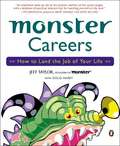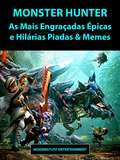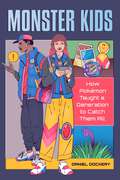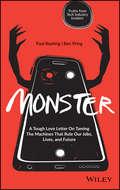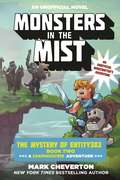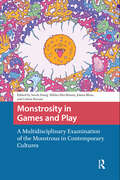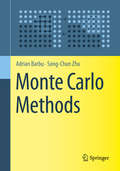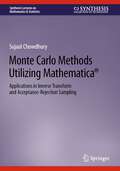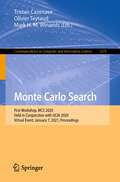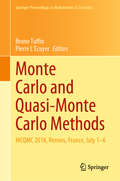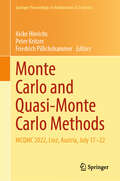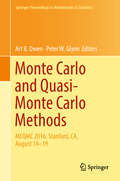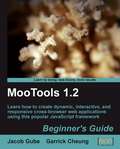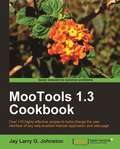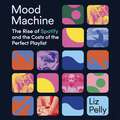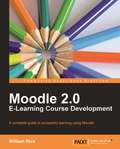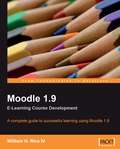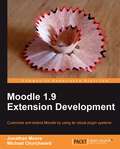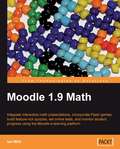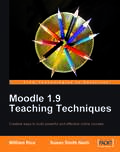- Table View
- List View
Monster Careers: How To Land The Job Of Your Life
by Jeff Taylor Doug HardyPacked with real-world advice from recruiters, career counselors, human resource professionals, and dozens of Monster members who have found rewarding employment through the world's leading global online job network, Monster Careers provides a step-by-step plan for carrying out a supercharged job search-from exploring new career options to writing job-winning resumes and cover letters to mastering the interview and negotiating a job offer. You'll also learn how to thrive in your first months in the new job and set yourself up for continuing success. Whether you're a seasoned professional or a recent graduate, whatever your job situation, this practical and passionate guide will show you the way to build a meaningful and rewarding career.
Monster Hunter As Mais Engraçadas Épicas e Hilárias Piadas & Memes
by Joke FactoryVocê desvendará as mais divertidas piadas de Monster Hunter de todos os tempos. Este livro está repleto com algumas das mais engraçadas piadas de Monster Hunter. Descubra os temas mais populares da Corporação Monster Hunter, juntamente com piadas e memes bobos, ridículos e puramente hilários sobre eles! Baixe sua cópia imendiatamente! Compre hoje e descubra as mais populares piadas sobre Monster Hunter!
Monster Hunter: Die lustigsten Sprüche und Memes
by Joke FactorySie sind auf der Suche nach den lustigsten Witzen und Sprüchen aus dem Monster Hunter-Universum? Hier sind Sie genau richtig, Sie werden sich den Hintern ablachen! Entdecken Sie die lustigsten, um nicht zu sagen dümmsten, Witze und Memes aus der Welt der Monster Hunter Corporations! Am Besten schlagen Sie gleich zu! Heute kaufen und Spaß haben mit Monster Hunter!
Monster Kids: How Pokémon Taught a Generation to Catch Them All
by Daniel DockeryThe definitive, behind-the-scenes look at why Pokémon's evolution from a single Japanese video game to global powerhouse captured the world's attention, and how the "gotta catch 'em all" mentality of its fanbase shaped pop culture—and continues to do so today. More than just a simple journey through the history of Pokémon, Daniel Dockery offers an in-depth look at the franchise&’s many branches of impact and influence. With dozens of firsthand interviews, Monster Kids covers its beginnings as a Japanese video game created to recapture one man's love of bug-collecting as a child before diving into the decisions and conditions that would ultimately lead to that game's global domination. With its continued growth as television shows, spin-off video games, blockbuster movies, trading cards, and toys, Pokémon is a unique and special brand that manages to continue to capture the attention and adoration of its eager fanbase 25 years after its initial release. Whether it was new animated shows like Digimon, Cardcaptors, and Yu-Gi-Oh!; the rise of monster-catching video games and trading card games; and more, Pikachu, the king of pop culture in the '90s, opened the doors in America to those hoping to capture some of Pokémon's dedicated fans. In Monster Kids, Dockery combines the personal stories of the people who helped bring Pokémon to the global stage with affection and humor, making this book the ultimate look at the rise of the franchise in Japan and then North America, but also the generation of kids whose passion for "catching them all" created a unique cultural phenomenon that continues to make a profound impact today.
Monster Savings (Freestylers: Data Beast #4)
by Andrew Fusek PetersA short thriller that's high on suspense! This is a perfect page turner if you want to finish a story in one sitting, especially for reluctant and struggling readers. Cool, edgy computer hackers, Kiran and Roz are teens who set out to fight crime and injustice with the help of a shape-shifting data beast they've created.In Monster Savings, Kiran and Roz take on the might of shopping phenomenon everythingonearth.com, a company that sells anything to anyone, but evades tax and avoids giving its workers fair pay and conditions. It's the data beast's most perilous mission yet - will it survive?Reading level for this book:-ATOS: 2.6Lexile ® Measure: 360LBook Band: 11 Lime
Monster: A Tough Love Letter On Taming the Machines that Rule our Jobs, Lives, and Future
by Paul Roehrig Ben PringLearn to tame technology's role in your life and work through 13 easy steps Monster: A Tough Love Letter on Taming the Machines that Rule our Jobs, Lives, and Future is an insightful exploration of how we can responsibly engage with technology We can maintain our freedom and privacy while still realizing the benefits that tech offers; Monster shows us how. The book offers readers an original view of big tech that includes discussions of: The addictive nature of many modern technology platforms and how to combat bad habits The growing backlash against big tech and how people are growing increasingly disenchanted with its impacts How to tame technology's role in your life and firm without becoming a modern Luddite Perfect for managers, leaders, and employees at companies of all sizes and in all industries, Monster will also earn a place in the libraries of technology enthusiasts who are growing increasingly wary of technology's role in their life and the lives of the people around them.
Monsters in the Mist: The Mystery of Entity303 Book Two: A Gameknight999 Adventure: An Unofficial Minecrafter's Adventure (Gameknight999 Series #2)
by Mark ChevertonGameknight999 is hot on the trail of Entity303, who has kidnapped Weaver. He follows the mysterious villain into the strange mod world of Mystcraft, with green skies, trees with blue leaves, floating islands, and a blood-red moon.Entity303 makes his way to a tower made of sparkling blue crystals, where he steals a linked book from the User-that-is-not-a-user, disappearing into one of Mystcraft’s many ages.Without the linked book, Gameknight has no way of ever leaving Mystcraft and returning to the Overworld. And besides, he can’t leave with rescuing Weaver and sending him back to the past, which would repair Minecraft’s timeline, making things right in the game once again.The User-that-is-not-a-user has no choice but to visit each age, in hopes of finding the right one. But in the process he’ll discover an unsettling truth about Entity303, and the deadly monsters the villain has left in wait for him.Sky Pony Press, with our Good Books, Racehorse and Arcade imprints, is proud to publish a broad range of books for young readers-picture books for small children, chapter books, books for middle grade readers, and novels for young adults. Our list includes bestsellers for children who love to play Minecraft; stories told with LEGO bricks; books that teach lessons about tolerance, patience, and the environment, and much more. While not every title we publish becomes a New York Times bestseller or a national bestseller, we are committed to books on subjects that are sometimes overlooked and to authors whose work might not otherwise find a home.
Monstrosity in Games and Play: A Multidisciplinary Examination of the Monstrous in Contemporary Cultures (Games and Play)
by Joleen Blom Sarah Stang Mikko Meriläinen Lobna HassanMonsters fascinate us. From ancient folklore to contemporary digital games, they are at the core of the stories we tell. They reflect our fears, deepest desires, and the monstrosity hidden within ourselves. Monsters hold a mirror to our contemporary society and reveal who we truly are. This edited collection examines monsters and monstrosity in games and play. Monsters are a key feature of most games: we fight, kill, and eat them—and sometimes, we become them. However, monsters in games and play are not only entertaining but also a reflection of the monstrosity of our world. In this book, twenty-two scholars explore how themes such as mental health, colonialism, individualism, disability, gender, sexuality, racism, and exclusion are reflected in the monsters we interact with in games, play, and our daily lives both online and offline. Monstrosity in Games and Play is recommended to readers interested in the monstrous in contemporary game cultures and their surrounding societies.
Monte Carlo Methods
by Adrian Barbu Song-Chun ZhuThis book seeks to bridge the gap between statistics and computer science. It provides an overview of Monte Carlo methods, including Sequential Monte Carlo, Markov Chain Monte Carlo, Metropolis-Hastings, Gibbs Sampler, Cluster Sampling, Data Driven MCMC, Stochastic Gradient descent, Langevin Monte Carlo, Hamiltonian Monte Carlo, and energy landscape mapping. Due to its comprehensive nature, the book is suitable for developing and teaching graduate courses on Monte Carlo methods. To facilitate learning, each chapter includes several representative application examples from various fields. The book pursues two main goals: (1) It introduces researchers to applying Monte Carlo methods to broader problems in areas such as Computer Vision, Computer Graphics, Machine Learning, Robotics, Artificial Intelligence, etc.; and (2) it makes it easier for scientists and engineers working in these areas to employ Monte Carlo methods to enhance their research.
Monte Carlo Methods Utilizing Mathematica®: Applications in Inverse Transform and Acceptance-Rejection Sampling (Synthesis Lectures on Mathematics & Statistics)
by Sujaul ChowdhuryThis book provides practical demonstrations of how to carry out definite integrals with Monte Carlo methods using Mathematica. Random variates are sampled by the inverse transform method and the acceptance-rejection method using uniform, linear, Gaussian, and exponential probability distribution functions. A chapter on the application of the Variational Quantum Monte Carlo method to a simple harmonic oscillator is included. These topics are all essential for students of mathematics and physics. The author includes thorough background on each topic covered within the book in order to help readers understand the subject. The book also contains many examples to show how the methods can be applied.
Monte Carlo Search: First Workshop, MCS 2020, Held in Conjunction with IJCAI 2020, Virtual Event, January 7, 2021, Proceedings (Communications in Computer and Information Science #1379)
by Tristan Cazenave Mark H. M. Winands Olivier TeytaudThis book constitutes the refereed proceedings of the First Workshop on Monte Carlo Search, MCS 2020, organized in conjunction with IJCAI 2020. The event was supposed to take place in Yokohama, Japan, in July 2020, but due to the Covid-19 pandemic was held virtually on January 7, 2021. The 9 full papers of the specialized project were carefully reviewed and selected from 15 submissions. The following topics are covered in the contributions: discrete mathematics in computer science, games, optimization, search algorithms, Monte Carlo methods, neural networks, reinforcement learning, machine learning.
Monte Carlo Simulation in Statistical Physics: An Introduction (Graduate Texts in Physics #Vol. 80)
by Kurt Binder Dieter W. HeermannThe sixth edition of this highly successful textbook provides a detailed introduction to Monte Carlo simulation in statistical physics, which deals with the computer simulation of many-body systems in condensed matter physics and related fields of physics and beyond (traffic flows, stock market fluctuations, etc.). Using random numbers generated by a computer, these powerful simulation methods calculate probability distributions, making it possible to estimate the thermodynamic properties of various systems. The book describes the theoretical background of these methods, enabling newcomers to perform such simulations and to analyse their results. It features a modular structure, with two chapters providing a basic pedagogic introduction plus exercises suitable for university courses; the remaining chapters cover major recent developments in the field.This edition has been updated with two new chapters dealing with recently developed powerful special algorithms and with finite size scaling tools for the study of interfacial phenomena, which are important for nanoscience. Previous editions have been highly praised and widely used by both students and advanced researchers.
Monte Carlo and Quasi-Monte Carlo Methods: MCQMC 2018, Rennes, France, July 1–6 (Springer Proceedings in Mathematics & Statistics #324)
by Bruno Tuffin Pierre L’EcuyerThis book presents the refereed proceedings of the 13th International Conference on Monte Carlo and Quasi-Monte Carlo Methods in Scientific Computing that was held at the University of Rennes, France, and organized by Inria, in July 2018. These biennial conferences are major events for Monte Carlo and quasi-Monte Carlo researchers. The proceedings include articles based on invited lectures as well as carefully selected contributed papers on all theoretical aspects and applications of Monte Carlo and quasi-Monte Carlo methods. Offering information on the latest developments in these very active areas, this book is an excellent reference resource for theoreticians and practitioners interested in solving high-dimensional computational problems, arising, in particular, in finance, statistics and computer graphics.
Monte Carlo and Quasi-Monte Carlo Methods: MCQMC 2022, Linz, Austria, July 17–22 (Springer Proceedings in Mathematics & Statistics #460)
by Friedrich Pillichshammer Peter Kritzer Aicke HinrichsThis book presents the refereed proceedings of the 15th International Conference on Monte Carlo and Quasi-Monte Carlo Methods in Scientific Computing that was held in Linz, Austria, and organized by the Johannes Kepler University Linz and the Austrian Academy of Sciences, in July 2022. These biennial conferences are major events for Monte Carlo and quasi-Monte Carlo researchers. The proceedings include articles based on invited lectures as well as carefully selected contributed papers on all theoretical aspects and applications of Monte Carlo and quasi-Monte Carlo methods. Offering information on the latest developments in these highly active areas, this book is an excellent reference resource for theoreticians and practitioners interested in solving high-dimensional computational problems, in particular arising in finance, statistics and computer graphics.
Monte Carlo and Quasi-Monte Carlo Methods: Mcqmc 2016, Stanford, Ca, August 14-19 (Springer Proceedings in Mathematics & Statistics #241)
by Peter W. Glynn Art B. OwenThis book presents the refereed proceedings of the Twelfth International Conference on Monte Carlo and Quasi-Monte Carlo Methods in Scientific Computing that was held at Stanford University (California) in August 2016. These biennial conferences are major events for Monte Carlo and quasi-Monte Carlo researchers. The proceedings include articles based on invited lectures as well as carefully selected contributed papers on all theoretical aspects and applications of Monte Carlo and quasi-Monte Carlo methods. Offering information on the latest developments in these very active areas, this book is an excellent reference resource for theoreticians and practitioners interested in solving high-dimensional computational problems, arising in particular, in finance, statistics, computer graphics and the solution of PDEs.
MooTools 1.2 Beginner's Guide
by Garrick Cheung Jacob GubeThis is a Packt Beginner's Guide, which means it is packed with clear step-by-step instructions for performing the most useful tasks in MooTools. You will learn by doing and you will start learning immediately. As each chapter in the book progresses, the topics will get increasingly more complex. It starts by explaining the fundamentals of MooTools before undertaking tasks and challenges that encourage experimentation. This book is perfect for MooTools newcomers. You do not require any familiarity with MooTools whatsoever, only a willingness to learn. Basic knowledge of JavaScript syntax and concepts is the only requirement. This book will allow you to grasp the basics of MooTools so that you will be well on the way to creating exciting, customizable web pages and applications.
MooTools 1.3 Cookbook
by Jay Larry JohnstonThis is a cookbook full of recipes with the essential code explained clearly and comprehensively. The recipes are organized so well that you will have no problems in using this cookbook as a reference too.Users of all skill levels will find this book useful. Advanced users will expand their knowledge of MooTools interaction, intermediate users will delve into new concepts of usage. Novice users will find they are carefully taken through each facet of knowledge necessary to rapidly become intermediate users.
Mood Machine: The Rise of Spotify and the Costs of the Perfect Playlist
by Liz Pelly'Passionate and rigorous... riveting' Financial Times'[a] cool-headed but powerful polemic...' Sunday TimesAn unsparing investigation into Spotify's origins and influence on music, weaving unprecedented reporting with incisive cultural criticism, illuminating how streaming is reshaping music for listeners and artists alike.Drawing on over a hundred interviews with industry insiders, former Spotify employees, and musicians, Mood Machine takes us to the inner workings of today's highly consolidated record business, showing what has changed as music has become increasingly playlisted, personalized, and autoplayed.Building on her years of wide-ranging reporting on streaming, music journalist Liz Pelly details the consequences of the Spotify model by examining both sides of what the company calls its two-sided marketplace: the listeners who pay with their dollars and data, and the musicians who provide the material powering it all. The music business is notoriously opaque, but here Pelly lifts the veil on major stories like streaming services filling popular playlists with low-cost stock music and the rise of new payola-like practices.For all of the inequities exacerbated by streaming, Pelly also finds hope in chronicling the artist-led fight for better models, pointing toward what must be done collectively to revalue music and create sustainable systems. A timely exploration of a company that has become synonymous with music, Mood Machine will change the way you think about and listen to music.
Mood Machine: The Rise of Spotify and the Costs of the Perfect Playlist
by Liz Pelly'Passionate and rigorous... riveting' Financial Times'[a] cool-headed but powerful polemic...' Sunday TimesAn unsparing investigation into Spotify's origins and influence on music, weaving unprecedented reporting with incisive cultural criticism, illuminating how streaming is reshaping music for listeners and artists alike.Drawing on over a hundred interviews with industry insiders, former Spotify employees, and musicians, Mood Machine takes us to the inner workings of today's highly consolidated record business, showing what has changed as music has become increasingly playlisted, personalized, and autoplayed.Building on her years of wide-ranging reporting on streaming, music journalist Liz Pelly details the consequences of the Spotify model by examining both sides of what the company calls its two-sided marketplace: the listeners who pay with their dollars and data, and the musicians who provide the material powering it all. The music business is notoriously opaque, but here Pelly lifts the veil on major stories like streaming services filling popular playlists with low-cost stock music and the rise of new payola-like practices.For all of the inequities exacerbated by streaming, Pelly also finds hope in chronicling the artist-led fight for better models, pointing toward what must be done collectively to revalue music and create sustainable systems. A timely exploration of a company that has become synonymous with music, Mood Machine will change the way you think about and listen to music.
Mood and Mobility: Navigating the Emotional Spaces of Digital Social Networks
by Richard CoyneAn argument that as we engage with social media on our digital devices we receive, modify, intensify, and transmit moods.We are active with our mobile devices; we play games, watch films, listen to music, check social media, and tap screens and keyboards while we are on the move. In Mood and Mobility, Richard Coyne argues that not only do we communicate, process information, and entertain ourselves through devices and social media; we also receive, modify, intensify, and transmit moods. Designers, practitioners, educators, researchers, and users should pay more attention to the moods created around our smartphones, tablets, and laptops.Drawing on research from a range of disciplines, including experimental psychology, phenomenology, cultural theory, and architecture, Coyne shows that users of social media are not simply passive receivers of moods; they are complicit in making moods. Devoting each chapter to a particular mood—from curiosity and pleasure to anxiety and melancholy—Coyne shows that devices and technologies do affect people's moods, although not always directly. He shows that mood effects are transitional; different moods suit different occasions, and derive character from emotional shifts. Furthermore, moods are active; we enlist all the resources of human sociability to create moods. And finally, the discourse about mood is deeply reflexive; in a kind of meta-moodiness, we talk about our moods and have feelings about them. Mood, in Coyne's distinctive telling, provides a new way to look at the ever-changing world of ubiquitous digital technologies.
Moodle 1.9 E-Learning Course Development
by William RiceWilliam Rice is an experienced trainer and expert on learning and teaching practices. This experience and expertise forms the foundation of his approach: What do we want to teach? How would this best translate into a course? How best can Moodle support these course objectives? Of course, the book contains everything you'd expect from an introduction to Moodle: clear step-by-step instructions, plenty of screenshots, explanations and guides through the many features and options that you have to choose from. Throughout the book, William develops an example course. He uses this example to explore the sort of decisions, design considerations, and thought that goes into developing a successful course. This book is for anyone who wants to get the best from Moodle. Beginners will get a thorough guide to how the software works, with great ideas for getting off to a good start with their first course. More experienced Moodlers will find powerful insights into developing more successful and educational courses.
Moodle 1.9 E-Learning Course Development
by William RiceWilliam Rice is an experienced trainer and expert on learning and teaching practices. This experience and expertise forms the foundation of his approach: What do we want to teach? How would this best translate into a course? How best can Moodle support these course objectives? Of course, the book contains everything you'd expect from an introduction to Moodle: clear step-by-step instructions, plenty of screenshots, explanations and guides through the many features and options that you have to choose from. Throughout the book, William develops an example course. He uses this example to explore the sort of decisions, design considerations, and thought that goes into developing a successful course. This book is for anyone who wants to get the best from Moodle. Beginners will get a thorough guide to how the software works, with great ideas for getting off to a good start with their first course. More experienced Moodlers will find powerful insights into developing more successful and educational courses.
Moodle 1.9 Extension Development
by Jonathan MooreThe author's experience as a Moodle developer enables him to combine a simple, descriptive how-to approach with enthusiastic insights into the rich potential of customizing Moodle according to your needs. The chapters gradually build up your skills and by the end of the book you will be confident enough to customize Moodle on your own. This book is written for technologists who are interested in expanding Moodle's functions through programming, either for their own organizations or to contribute to the open source project. You should be familiar with Moodle's basic technologies: PHP, MySQL ,and HTML/CSS.
Moodle 1.9 Math
by Ian WildThe book presents the reader with clear instructions for setting up specific activities, based around an example maths course (Pythagorean Theorem) with plenty of examples and screenshots. No Moodle experience is required to use the book, but the book will focus only on activities and modules relevant to teaching mathematics. We will assume that the reader has access to a working installation of Moodle. The activities will be appropriate for teaching math in high schools and universities. The book is aimed at math teachers who want to use Moodle to deliver or support their teaching. The book will also be useful for teachers of "mathematical sciences", or courses with a significant mathematical content that will benefit from the use of some of the tools explored in the book.
Moodle 1.9 Teaching Techniques
by Susan Smith Nash William RiceThis book contains clear guidance for all who want to put together effective online courses that motivate students and encourage dynamic learning. There are clear, step-by-step instructions with helpful screenshots and diagrams to guide you along the way. If you want to unleash your teaching talents and develop exciting, dynamic courses that really get students moving forward, then this book is for you. Experienced Moodlers who want to upgrade to Moodle 1.9 will find powerful insights into developing more successful and educational courses.
